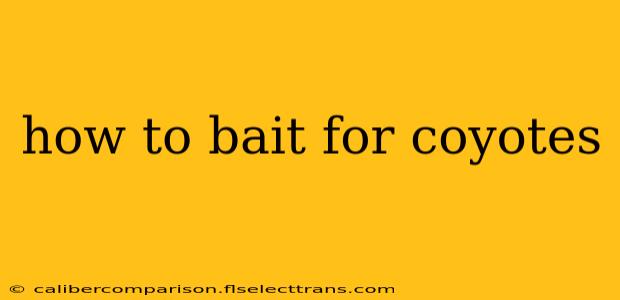Coyotes, known for their intelligence and elusiveness, present a unique challenge for hunters. Baiting can significantly improve your chances of success, but it requires careful planning, legal compliance, and a deep understanding of coyote behavior. This guide provides comprehensive information on how to bait for coyotes effectively and ethically.
Understanding Coyote Behavior and Baiting Strategies
Before delving into specific baiting techniques, it's crucial to grasp coyote behavior. Coyotes are opportunistic omnivores, meaning their diet is varied and adaptable. This adaptability makes them receptive to various baits, but understanding their preferences is key to success.
What attracts Coyotes?
-
Scent: Coyotes possess an incredibly sensitive sense of smell. Strong-smelling baits are more effective. Consider using scents associated with natural prey, such as urine, glands, or even commercially available coyote lures.
-
Sound: While not as crucial as scent, sounds can enhance your baiting strategy. Distress calls from rabbits or other prey animals can draw coyotes in from a distance.
-
Sight: While coyotes primarily rely on scent and sound, the visibility of the bait can also influence their approach. Placing the bait in an open area, while maintaining sufficient cover for yourself, can be beneficial.
-
Location: Strategic placement of your bait is paramount. Choose locations where coyotes are known to travel, such as near known dens, along trails, or in areas with abundant prey. Consider natural funnels or choke points where coyotes are more likely to pass.
Types of Coyote Baits
Several baiting options exist, each with its own advantages and disadvantages:
-
Natural Baits: These include scraps of meat, fish, or roadkill (where legally permissible). They offer a natural scent and are often highly effective but can attract unwanted scavengers.
-
Commercial Baits: Many commercially available coyote lures and attractants combine scents and attractants designed to appeal specifically to coyotes. These are convenient but can be more expensive.
-
Set Baits: This involves strategically placing bait near a trap or other hunting equipment. This requires a deep understanding of local regulations and ethical hunting practices.
Legal and Ethical Considerations
Before you begin baiting, thoroughly research and understand all local, state, and federal regulations regarding hunting coyotes and baiting. Regulations vary widely by location, and violations can result in significant penalties.
Ethical Hunting Practices
-
Minimize Damage to the Environment: Avoid leaving behind excess bait or trash. Dispose of all waste properly.
-
Respect Private Property: Always obtain permission from landowners before hunting or baiting on their property.
-
Ensure Humane Treatment of Animals: If using traps, ensure they are set and checked regularly according to ethical trapping guidelines to minimize suffering.
-
Target Only Coyotes: Avoid baiting in a manner that could unintentionally attract other animals.
Setting Up Your Bait Station
Properly setting up your bait station is crucial for maximizing your chances of attracting coyotes. Consider these factors:
-
Location: As mentioned earlier, select a strategic location based on coyote activity and terrain.
-
Scent Dispersion: Consider the wind direction when placing your bait to ensure the scent travels effectively.
-
Concealment: While you want the coyotes to find the bait, you also need sufficient cover for your own hunting position.
-
Safety: Always prioritize safety. Never approach a coyote directly or unnecessarily. Maintain a safe distance, and be aware of your surroundings.
Monitoring and Adjustment
Baiting is not a one-size-fits-all approach. You may need to experiment with different baits, locations, and methods to determine what works best in your specific area. Regularly monitor your bait station and make adjustments as needed.
Conclusion
Baiting for coyotes can be an effective hunting strategy, but it necessitates careful planning, legal compliance, and a deep understanding of coyote behavior and ethical hunting practices. By following these guidelines, you can significantly increase your chances of a successful hunt while upholding responsible and ethical hunting standards. Remember to always prioritize safety and legality in all your hunting endeavors.

